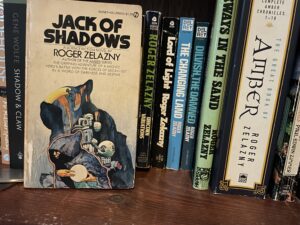
I have at last managed to fill in a lacuna in my Appendix N reading. Jack of Shadows is, in someways, Roger Zelazny condensed to the quintessence. A synecdoche of a sort. If you’ve read much Zelazny, you’ll recognize themes: resurrection, from Lord of Light; the corrupting nature of absolute power, from Amber; the ambiguously amoral nature of demonic and monstrous beings, from Dilvish the Damned and A Night in the Lonesome October.
Jack of Shadows is set on a tidally locked earth. Whether that occurred naturally or supernaturally is left unstated, though a supernatural origin is hinted at. The dark side is the realm of magic and generally evil or morally equivocal creatures. The light side (which gets short shrift) is the realm of science, essentially 1970s America. (Commence Digression: Reading this section, in which Zelazny refers to supersonic flight as a matter of course, left me feeling melancholy. There was a time during which we went to the moon, traveled in supersonic passenger jets, and generated electricity through nuclear power. Had those technologies been allowed to develop along the same trajectory as computing, medicine, and biology, what glorious existence would we be enjoying? End Digression.)
I won’t summarize the plot. That’s something for the reader to enjoy and puzzle out himself, with its deliberately unreliable narrators. Jack begins as a sort of roguish, amoral thief. An antihero. His overwhelming, all consuming desire for revenge leads him along a path toward villainy, to the extent that he becomes in effect the traditional fantasy Dark Lord. There is a luciferian quality to him, which is emphasized by his sole friendship with a bound, gigantic figure named Morningstar. His remaining redeeming features: love, friendship, and gratitude, impel him on a sort of descent into the underworld to perform an apocalyptic act of destruction which leads to a sort of Promethean redemption.
All this and swordplay, magic, weird spectacles, and bizarre settings compacted to 142 pages. There is the merest hint of Elric about the book. Just a whiff, nothing more. Readers who want the plot and setting neatly set out, with the internal logic fully explicated might not enjoy this one nearly as much as I did. Sometimes I feel the same way, wanting something more de Campian. But Zelazny — to my mind, at any rate — neatly pulled off the trick of satisfactorily providing nothing more than hints, suggestions, and allusions.
If this web log post put you in the mood for reading a fantasy set somewhat off the beaten path, give Thick as Thieves a try. You’ll enjoy it. (I mean, just because I have something to gain is no reason not to trust me.)
